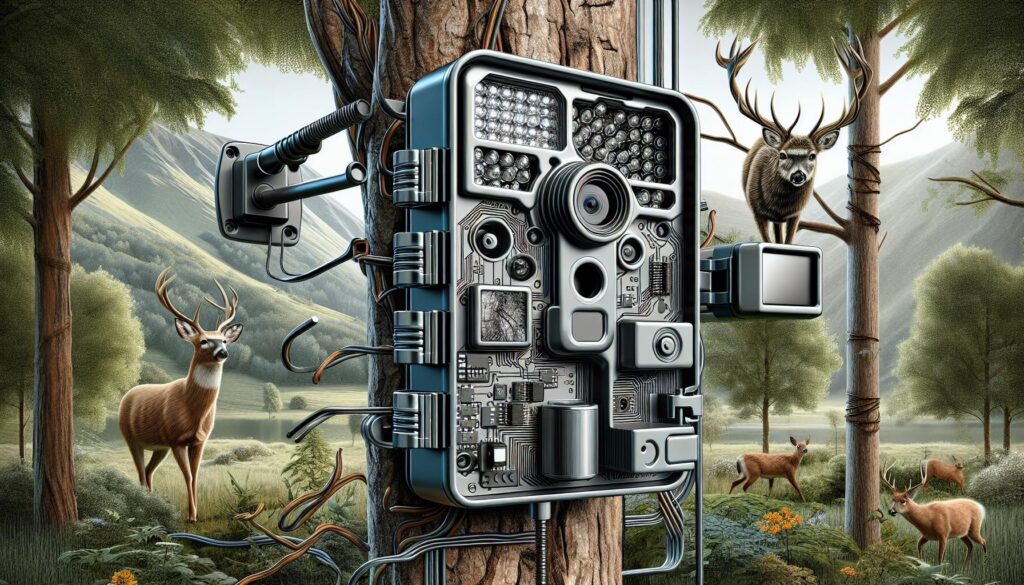Trail cameras work by using motion and heat sensors to detect movement, triggering the camera to capture photos or videos. Trail cameras utilize motion and heat sensors to detect movement, allowing them to automatically capture photos or videos.
These cameras are commonly used in wildlife research, hunting, or home security, as they provide a non-intrusive method of monitoring specific areas. Once triggered, the camera’s sensors send a signal to the camera to take a photo or record a video.
The captured images or videos are then saved to an internal memory card or transmitted wirelessly to a connected device. With advancements in technology, trail cameras now offer high-resolution images, video capabilities, and long battery life, making them highly effective for outdoor surveillance and wildlife observation.
Table of Contents
Understanding The Basics
Trail cameras operate by capturing images or videos using motion-sensing technology. These cameras, commonly used in wildlife observation, detect movement and trigger the camera to capture the scene. The captured images or videos can then be reviewed later for analysis.
Trail cameras have a fascinating history, starting from their development in the 1980s. Their importance in wildlife observation cannot be overstated, as they provide researchers and nature enthusiasts with a unique window into the lives of animals in their natural habitats.
By studying the behavior, habits, and movements of different species, scientists can gather valuable data for conservation efforts and wildlife management. Trail cameras have become an indispensable tool in understanding and protecting our natural world.
The Mechanics Behind Trail Cameras
Trail cameras function by combining various components to capture images of wildlife and outdoor activities. These devices utilize special mechanisms for image capture, such as infrared sensors and LED flash, enabling them to capture clear and detailed photos. The triggering systems, including motion sensors and timers, detect movement and activate the camera to ensure accurate and timely photo capture.
To power these cameras, a variety of power sources can be used, including batteries and solar panels, providing long-lasting and reliable operation. By understanding the mechanics behind trail cameras, users can effectively choose the right components and optimize their performance for outdoor adventures and wildlife monitoring.
Whether for hunting, research, or simply capturing stunning wildlife moments, trail cameras offer a valuable tool for understanding and appreciating the natural world.
Exploring Trail Camera Features
Trail cameras work by capturing images and videos of wildlife in their natural habitats. These cameras have various features that contribute to their effectiveness. Image resolution and quality determine the clarity and detail of the captured footage. Detection range and field of view play a crucial role in identifying the animals within the camera’s range.
Different flash types, such as infrared or white LED, impact the image capture by providing illumination without disturbing the animals. Time-lapse and video recording functions offer versatility as they can capture both snapshots and continuous footage. Understanding how different features work together can enhance the performance of trail cameras and provide valuable data for wildlife research and observation.
Ultimately, these cameras serve as valuable tools in monitoring and documenting the behavior of animals in their natural environments.
Choosing The Right Trail Camera
Trail cameras work by capturing photos and videos of wildlife or other outdoor activities. When choosing the right trail camera, there are several factors to consider before purchasing. Firstly, popular brands and models tend to offer reliable performance and advanced features.
It’s also important to take into account your budget and look for budget-friendly options that still meet your needs. Additionally, considering tips for maintenance and longevity can help ensure your trail camera remains in good condition and lasts for a long time.
Keeping these factors in mind will help you make an informed decision and enjoy the benefits of using a trail camera effectively.
Advanced Techniques And Tips For Trail Camera Use
Trail cameras work by capturing images or videos when they detect motion or heat signatures. Placement and positioning strategies are crucial for effective trail camera use. Avoiding common mistakes is important when setting up, such as ensuring proper height and angle.
To optimize battery life and memory storage, use high-quality batteries and SD cards with large capacity. Analyzing trail camera data can reveal wildlife patterns, helping to improve hunting or wildlife observation. Utilize different phrases at the beginning of paragraphs to engage readers and maintain their interest.
Remember to position the trail camera appropriately and avoid common mistakes to achieve desired results. Additionally, optimize battery life and memory storage for longer operation. Moreover, analyzing captured data is crucial for understanding wildlife patterns and habits. Use these advanced techniques and tips to enhance your trail camera experience.
Ethical And Legal Considerations
Trail cameras are a valuable tool for wildlife enthusiasts, but ethical and legal considerations must be taken into account. Wildlife protection laws are in place to safeguard vulnerable species and their habitats. Respecting privacy boundaries is crucial when using trail cameras, ensuring minimal disruption to the natural behavior of animals.
Invasive species pose a significant threat to ecosystems, and trail cameras can aid in detecting and monitoring their presence. Additionally, the environmental impact of trail camera usage should be considered, as excessive use can result in habitat disturbance. Understanding and abiding by these ethical and legal considerations is essential for responsible trail camera use.
It allows us to appreciate wildlife while minimizing our impact on their well-being and preserving the delicate balance of our natural ecosystems.
Trail Cameras Beyond Wildlife Monitoring
Trail cameras play a crucial role beyond wildlife monitoring, particularly in hunting and game management applications. These cameras are also widely used for security and surveillance purposes, ensuring the safety of various areas. One of the key advantages of trail cameras is their ability to capture rare or elusive species, providing valuable insights into the behavior and population dynamics of these creatures.
With their motion-activated sensors and high-resolution imaging capabilities, trail cameras have revolutionized the field of wildlife research and management. By operating silently and inconspicuously in remote locations, they enable researchers to collect data without disturbing the natural habitat or behavior of the animals being studied.
Whether it’s for hunting, security, or conservation efforts, trail cameras have proven to be a valuable tool in understanding and monitoring wildlife populations.
Future Trends In Trail Camera Technology
Trail cameras work by capturing images or videos when motion or heat is detected. These cameras have evolved over time, and future trends in trail camera technology are focused on improving image quality and resolution. Innovations in this area aim to provide sharper and more detailed visual data.
Additionally, trail cameras are now equipped with wireless and remote access features, allowing users to view and manage the captured content from a distance. Furthermore, integration with artificial intelligence and machine learning algorithms has become prominent in trail camera technology, enabling advanced data analysis and enhancing the camera’s ability to detect and identify animals or objects accurately.
These advancements in trail camera technology are revolutionizing wildlife monitoring and research.

Credit: reolink.com
Frequently Asked Questions For How Do Trail Cameras Work
Do Trail Cameras Need Internet?
No, trail cameras do not need internet to function. They work independently and without internet connectivity.
Do Trail Cameras Record All The Time?
No, trail cameras do not record all the time. They only record when triggered by motion or heat.
Do You Have To Pay A Monthly Fee For Cellular Trail Camera?
No, you do not have to pay a monthly fee for a cellular trail camera.
Can You Watch A Trail Camera From Your Phone?
Yes, you can view a trail camera from your phone for real-time monitoring.
Conclusion
Trail cameras are remarkable devices that have revolutionized wildlife monitoring and research. By blending technology and photography, these cameras offer a unique glimpse into the lives of animals in their natural habitats. The innovative design allows them to capture high-quality images and videos day or night, providing valuable insights into animal behavior and population dynamics.
With their motion and heat sensors, trail cameras can be strategically placed to maximize their effectiveness in recording animal activities. The captured data not only aids in scientific studies but also benefits outdoor enthusiasts and hunters for scouting purposes. With continuous advancements in trail camera technology, we can expect even more sophisticated features and functionalities in the future.
So, whether you are a wildlife researcher, a nature lover, or an avid hunter, trail cameras are an invaluable tool that will continue to enhance our understanding and appreciation of the natural world.














